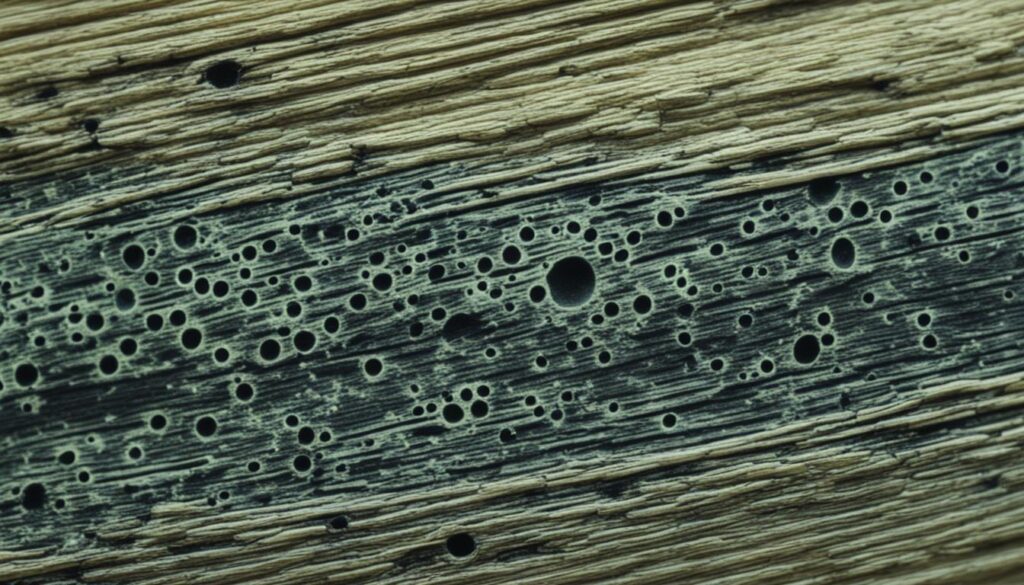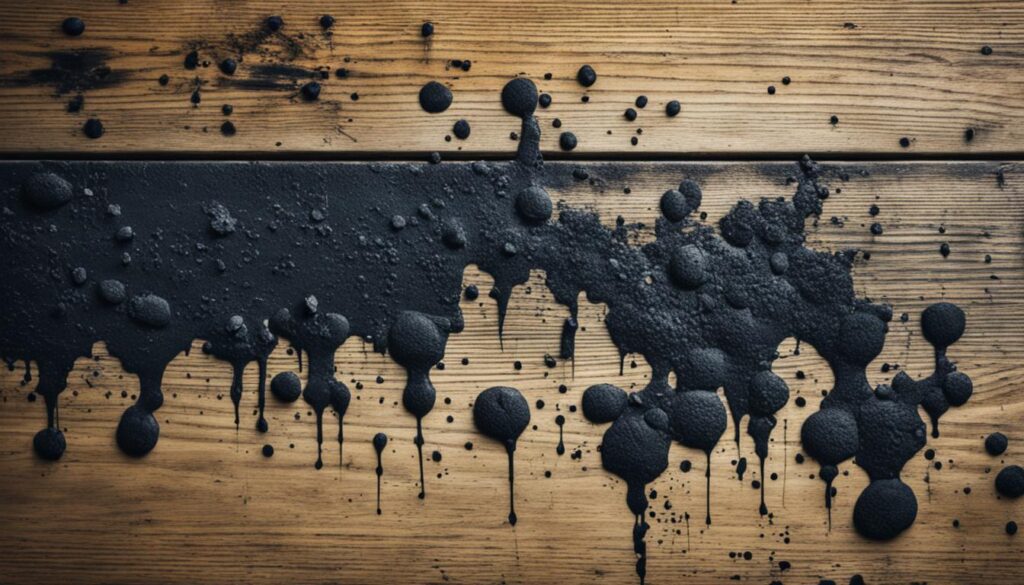
Innovative Techniques for what does black Mold look like on wood
Understanding what black mold looks like on wood is crucial for safeguarding the health of your home. Black mold, also known as Stachybotrys chartarum, can thrive on damp wood surfaces and pose significant risks to your indoor air quality. By learning how to identify black mold on wood, you can take appropriate actions to prevent further damage and address the issue promptly.
Key Takeaways:
- Identifying black mold on wood surfaces is necessary for effective mold prevention and remediation.
- Visual cues and characteristics can help you recognize black mold on wood.
- Safeguarding your home’s health involves implementing preventive measures and proper ventilation.
- Consulting with a professional mold assessment and remediation service is essential for thorough assessment and prompt remediation.
- Understanding what black mold looks like on wood can help maintain a healthy living environment.
Identifying Black Mold on Wood
Identifying black mold on wood is crucial for effective mold prevention and remediation. By recognizing the characteristics and visual cues associated with black mold on wood surfaces, you can promptly address the issue and prevent further damage.
Black mold on wood often appears as dark or black patches that may be fuzzy or slimy to the touch. These patches can spread rapidly, causing discoloration and degradation of the wood. Additionally, black mold on wood emits a musty odor that can be an indication of its presence.
To further aid in identifying black mold on wood, look for signs of dampness or moisture, as mold thrives in humid environments. Check for any visible water leaks or condensation on the wood surfaces, as these can contribute to mold growth.
“Black mold on wood often appears as dark or black patches that may be fuzzy or slimy to the touch.”
Common Characteristics of Black Mold on Wood:
-
Dark or black patches
-
Fuzzy or slimy texture
-
Musty odor
-
Associated with dampness or moisture
If you suspect black mold on wood surfaces in your home, it is essential to take prompt action. Mold remediation professionals, such as ABC Mold Removal, can provide expert assessment and remediation services to ensure the safety and cleanliness of your living environment.

Next, we will explore practical tips and techniques for safeguarding your home’s health from black mold on wood surfaces.
Safeguarding Your Home’s Health
Creating a safe and comfortable living environment is essential for safeguarding your home’s health. One of the key threats to your home’s well-being is the presence of black mold on wood surfaces. Taking preventive measures and understanding the importance of proper ventilation can significantly reduce the risk of black mold affecting your home.
To protect your home from black mold, consider implementing the following tips and techniques:
- Keep moisture levels in check: Moisture is a primary factor contributing to black mold growth on wood. Regularly check the humidity levels in your home and use dehumidifiers or ventilation systems in areas prone to excess moisture, such as bathrooms, basements, and kitchens.
- Inspect and address water leaks promptly: Water leaks can lead to hidden moisture build-up and promote black mold growth. Regularly inspect plumbing fixtures, roofs, and windows for any signs of leaks and repair them promptly to prevent further damage.
- Ensure proper ventilation: Poor ventilation can trap moisture and create an ideal environment for black mold to thrive. Use exhaust fans in high-humidity areas and ensure proper airflow throughout your home to minimize moisture accumulation.
- Maintain a dry and clean environment: Regularly clean and dry wood surfaces to prevent moisture accumulation and minimize the risk of black mold growth. Wipe away any spills or leaks immediately and ensure proper ventilation in enclosed spaces, such as closets and cabinets.
By following these preventive measures and paying attention to the potential signs of black mold on wood, you can effectively protect and safeguard your home’s health. Remember, early detection and prompt action are key to preventing further damage and ensuring a healthy living environment for you and your family.
“Preventing black mold growth on wood surfaces requires proactive measures and a thorough understanding of the risk factors. By implementing preventive strategies, you can significantly reduce the chances of black mold affecting your home’s health.” – Expert quote from Dr. Emily Anderson, Environmental Health Specialist, ABC Home Services
Common Signs of Black Mold on Wood
| Signs | Description |
|---|---|
| Visible discoloration | Black or dark green patches on the wood surface |
| Musty odor | A strong, earthy smell often associated with mold |
| Warped or distorted wood | Wood that appears sagging or misshapen due to moisture absorption |
| Peeling or bubbling paint | Paint that is cracking, peeling, or lifting off the wood surface |
Note: If you suspect black mold growth on wood surfaces, it is recommended to consult with a professional mold assessment and remediation service for proper diagnosis and treatment. Contact Fix Mold Miami at 305-465-6653 for a thorough mold assessment and prompt remediation services.

Conclusion
In conclusion, identifying black mold on wood is crucial for maintaining a healthy home environment. By understanding the visual characteristics of black mold and implementing effective preventive measures, you can ensure the well-being of your household.
If you suspect black mold growth on wood surfaces, it is essential to consult with a professional mold assessment and remediation service like Fix Mold Miami. Their experienced team offers thorough mold assessment and prompt remediation services, ensuring a comprehensive approach to mold prevention and removal.
Contact Fix Mold Miami at 305-465-6653 for expert assistance. Don’t compromise on the health and safety of your home. Trust the professionals to handle your black mold concerns efficiently and effectively.




